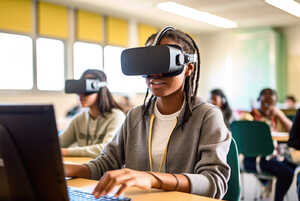Thought Leadership
The Future of Technology in Education
While the fundamentals of education have remained broadly consistent over the last century, in that children are grouped according to age groups and the curriculum is divided into subjects—in the last two decades, the rapid progression of technology has meant that schools, educators, and students have had to embrace and adapt to a new educational landscape; one characterised by digital tools and online resources, all the while upholding the values and practices of traditional learning methods.
As generations of students become ever more technology-fluent, and teachers are given the tools and training to use it effectively within schools and MATS, it’s often difficult to imagine just how deeply technology will become integrated into the classroom environment.
Just what will a classroom look like in 20 years' time?
No one can predict the future, of course, but with EdTech businesses generating between £3.7 billion to £4 billion in 2021, according to the latest Department of Education report, we can reasonably estimate that technology will remain a fundamental tool within the education system. Just as blackboards and chalk transformed into whiteboards and dry-wipe markers, so too will interactive displays make way for even more advanced digital tools, capable of delivering dynamic learning experiences for all. And that’s just the beginning…

From any device, from anywhere:
the classroom of the future
If there was just one positive byproduct of the pandemic, it was that it encouraged educators and stakeholders to reassess remote learning infrastructures. As the world becomes more connected, cloud technology will continue to promote innovative teaching methods and explore new ways to make education more accessible and adaptable to diverse learning needs.
With students already able to access online resources from any device, from anywhere, it’s conceivable that classrooms of the future will be entirely unaffected by geographical and societal boundaries. Blending learning models could become more prominent as students are able to supplement their traditional classroom environment with interactive, home-based learning.
With the world population growth increasing on average by 1% each year, and with the number of global internet users rising by 2% annually, flexible learning models seem like a logical solution to overcrowded classrooms, overburdened teachers, and budgetary restraints.
Personalised learning
Every child is different, and there is no one-size-fits-all solution when it comes to education. As well as the diverse range of academic capabilities that exist within a single classroom—particularly in primary schools—the ways in which children learn most effectively are also varied and unique. Some, for instance, respond better to visual stimuli, while others are more comfortable absorbing information from text sources. Online platforms, combined with traditional teaching methods, can adapt to an individual child’s style of learning. Through the cloud, teachers can create tailor-made education resources for their students; from multimedia presentations to customised tests and quizzes, with clearly defined learning objects for each child.
Through more personalised and accessible learning models, children will be given even more scope to excel in their stronger subjects, while finding the best educational framework to thrive in those lessons in which they might struggle—as well as accommodating those with learning disabilities.
As ever, as technology becomes more integrated within the classroom, it’s important to remember that these digital tools are just that…tools. Education models of the future should always look to adopt a pedagogically-led approach to technology; one that still necessitates engaged, passionate teachers who, through adequate training and skills upgrades, feel confident incorporating ICT into the whole curriculum rather than in isolation as part of a computing lesson.

Artificial intelligence and
virtual reality tools
It seems inevitable that classrooms of the future will be heavily invested in adaptive learning systems driven by artificial intelligence. As a natural progression from teachers creating personalised learning experiences for students, the advancement of AI will soon likely have the power to identify individual learning styles and formulate customised assessments which can change in real time according to performance. As well as freeing up more time for educators to engage in more traditional teaching practices, AI might also be able to anticipate student’s educational needs and highlight strengths and weaknesses with instant feedback and suggested course correction.
Virtual reality is already becoming a hugely valuable educational tool which can immerse students into engaging, real-world scenarios; particularly useful for those who might struggle to absorb or visualise information by conventional means.
Simulated environments can drop students into the heart of a subject, allowing them to feel connected with the topic they are exploring. Reading about the intricate inner workings of the human brain suddenly becomes an interactive learning experience which students can visualise and understand with much greater depth.
We might soon see interactive whiteboards, already a hugely effective learning tool that exists in classrooms, equipped with augmented reality functions. Virtual objects could be layered into real-world scenarios. Learning about the ancient city of Petra in Jordan can substitute words in a textbook into a virtual field trip; the bone structure of a velociraptor goes from a 2D diagram on a handout sheet to a fully interactive 3D model. The scope is almost inestimable.
The future of technology in
education: the next steps
While certain traditional teaching methods will always remain a staple in education, it’s important to identify which of those will still be relevant in the evolving world of technology in their current guise—particularly when taking into account the chosen career paths of our pupils. If the end goal is to give students the scope to become future innovators, then we must adapt our teaching methods and embrace technology.
Digital note taking and collaborative document sharing are basic practices in many workplaces now, and these are simple tools that can be embedded into the curriculum. Similarly, while there is always a place for fine art and ‘traditional mediums’, are we doing pupils a disservice if they’re not given the opportunity to learn about digital sketching or how to manipulate an apple pencil to create light and shade on a design application? No one is suggesting we wipe geography field trips off the curriculum, but will that experience be made that much richer if students can utilise technology to scan elements of nature and conclude findings about animal habits in that area?
Ultimately, schools have a commitment to follow the Gatsby Benchmarks of career guidance for pupils, and this should be considered when planning their curriculum; identifying trends that drive business transformation over the next decade and ensuring that chimes with the aspirations of their students.
How can Computeam help?
Whatever the future holds for education, it’s clear that our efforts to invest in technological infrastructure must align with students’ ongoing needs. To keep up with digital advancements, children must have access to the tools they require to thrive in this new educational environment, regardless of their location or background.
Meanwhile, educators should also be supported with ongoing training and resources to extract the full potential of new technology. A pedagogically-led approach to technology integration will ensure that teachers use these tools effectively, making them enablers of innovation rather than mere facilitators. If you’d like to find out more about how your school can benefit from technology, please get in touch.

The Power of Data-Driven Decision Making in Education
In this new paradigm, schools become more like businesses; often required to adopt almost corporate metrics for measuring success, and the use of advanced data collection and analysis has given agency to education institutions to become more profitable, improve student performance, and streamline processes.
Posted on October 20th 2023



 Learning Locker
Learning Locker Climate project
Climate project